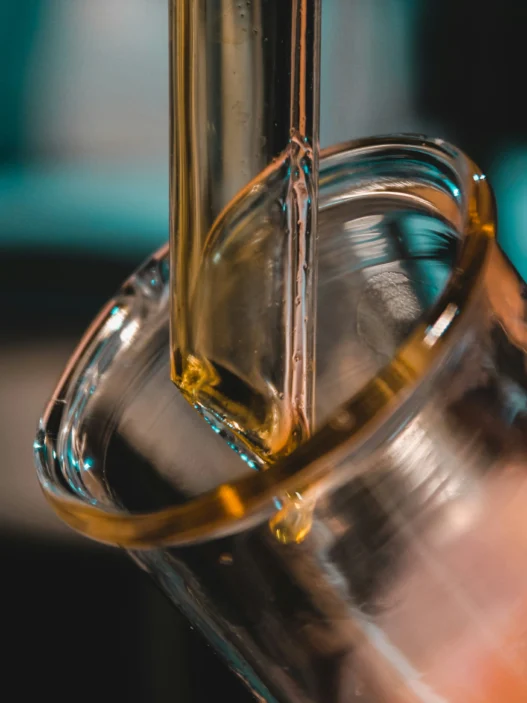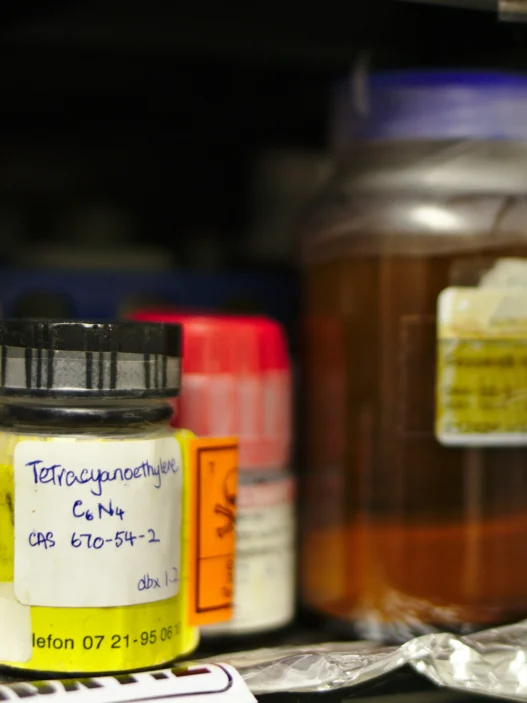Glyoxylic acid plays a vital role in various industries and everyday products. It is commonly used in the cosmetic and personal care industry as a hair straightening agent and as a component in hair dyes and skincare products. Additionally, it is utilized in the pharmaceutical industry for the synthesis of certain medications and in the food industry as a flavoring agent. Its versatile properties make it a key ingredient in many consumer products, highlighting its significance in everyday life.
Table of Contents:
- 💡 Commercial Applications
- ⚗️ Chemical & Physical Properties
- 🏭 Production & Procurement
- ⚠️ Safety Considerations
- 🔬 Potential Research Directions
- 🧪 Related Compounds
💡 Commercial Applications
Glyoxylic acid has several commercial and industrial applications, mainly in the production of various chemicals. It is commonly used as a precursor in the synthesis of pharmaceuticals, pesticides, and fine chemicals. Additionally, Glyoxylic acid is used in the manufacture of hair dyes, textile auxiliaries, and perfumes.
In the pharmaceutical industry, Glyoxylic acid is used in the production of certain drugs and medications. It is utilized as an intermediate in the synthesis of a variety of pharmaceutical compounds such as anti-cancer drugs, antiviral agents, and antibiotics. Glyoxylic acid’s ability to form various derivatives makes it a valuable component in drug development.
Due to its versatile nature, Glyoxylic acid is also used in the cosmetic industry for the production of hair care products. It is a key ingredient in hair straightening treatments due to its ability to break down protein bonds in the hair, allowing for reshaping and restructuring. Additionally, Glyoxylic acid is used in skincare products for its exfoliating properties, promoting smoother and brighter skin.
⚗️ Chemical & Physical Properties
Glyoxylic acid is a colorless crystalline solid with a strong, acrid odor. It is commonly found in aqueous solutions and has a chemical formula of C2H2O3. Its purity can vary depending on the source, but it is typically a white to off-white powder.
The molar mass of Glyoxylic acid is approximately 74.04 g/mol, and its density is about 1.463 g/cm³. As a point of comparison, common household items such as sugar and salt have molar masses ranging from 58.44 g/mol to 58.44 g/mol and densities ranging from 1.59 g/cm³ to 2.16 g/cm³.
Glyoxylic acid has a melting point of around 74.8°C and a boiling point of about 111.5°C. In comparison, common household items like butter have melting points ranging from 32°C to 35°C and boiling points ranging from 250°C to 300°C.
Glyoxylic acid is highly soluble in water and has a low viscosity. In comparison, common household items like salt and sugar are also highly soluble in water but have higher viscosities than Glyoxylic acid.
🏭 Production & Procurement
Glyoxylic acid is typically produced through the oxidation of oxalic acid or glyoxal in the presence of a strong oxidizing agent, such as nitric acid or permanganate. This process generally involves the use of elevated temperatures and acidic conditions to facilitate the reaction.
In terms of procurement and transportation, Glyoxylic acid is commonly available for purchase from chemical suppliers in both liquid and solid forms. It is typically packaged in barrels, drums, or bags to ensure safe handling during transportation. Due to its corrosive nature, Glyoxylic acid should be stored and transported in accordance with established safety guidelines to prevent accidental spills or exposure to individuals handling the substance.
⚠️ Safety Considerations
Safety considerations for Glyoxylic acid:
Glyoxylic acid should be handled with care due to its corrosive nature. It can cause irritation to the skin, eyes, and respiratory tract upon contact. When working with Glyoxylic acid, it is important to wear appropriate personal protective equipment, such as gloves, goggles, and a lab coat, to prevent any accidental exposure.
Pharmacology of Glyoxylic acid:
Glyoxylic acid is a natural compound found in various plants and animals. It is also used in the production of pharmaceuticals, agricultural chemicals, and cosmetics. Glyoxylic acid acts as an intermediate in the metabolism of amino acids and carbohydrates in the body. It has been studied for its potential therapeutic effects in the treatment of certain medical conditions.
Hazard statements for Glyoxylic acid:
Glyoxylic acid is classified as a hazardous substance due to its corrosive properties. It can cause severe burns and tissue damage upon contact with the skin or eyes. Inhalation of Glyoxylic acid fumes may also lead to respiratory irritation and difficulty breathing. It is important to handle Glyoxylic acid with caution and follow proper safety protocols to avoid any accidents or injuries.
Precautionary statements for Glyoxylic acid:
When working with Glyoxylic acid, it is essential to work in a well-ventilated area to prevent inhalation of fumes. It is recommended to wear appropriate personal protective equipment, including gloves, goggles, and a lab coat, to minimize the risk of exposure. In case of accidental contact with Glyoxylic acid, it is important to rinse the affected area with water immediately and seek medical attention if necessary. Store Glyoxylic acid in a cool, dry place away from incompatible substances to prevent any potential reactions.
🔬 Potential Research Directions
Research on Glyoxylic acid has shown promising potential in various fields. Its versatile chemical properties make it an interesting candidate for further study in organic synthesis and development of pharmaceuticals. Exploring its reactivity and compatibility with other compounds could lead to the discovery of new reactions and applications.
Furthermore, Glyoxylic acid has been recognized for its ability to act as a crosslinking agent in polymers, suggesting a role in the improvement of material properties. Investigating its effectiveness in enhancing the mechanical and thermal features of polymers could open up new avenues for the development of advanced materials with tailored properties.
In addition, the potential of Glyoxylic acid in environmental applications is an area ripe for exploration. Its role as a precursor in the synthesis of various chemicals, such as glyphosate, underscores its importance in the agricultural sector. Research focusing on the optimization of processes involving Glyoxylic acid could lead to more sustainable methods for chemical production.
🧪 Related Compounds
One similar compound to Glyoxylic acid based upon molecular structure is Oxalic acid. Oxalic acid has the molecular formula C2H2O4 and consists of two carboxylic acid groups connected by a single carbon atom. This compound also has acidic properties similar to Glyoxylic acid due to its carboxylic acid functional groups.
Another compound with a similar molecular structure to Glyoxylic acid is Malonic acid. Malonic acid has the molecular formula C3H4O4 and contains two carboxylic acid groups separated by two carbon atoms. Like Glyoxylic acid, Malonic acid is a dibasic acid, meaning it can donate two protons in acid-base reactions.
A third compound that shares a comparable molecular structure with Glyoxylic acid is Succinic acid. Succinic acid has the molecular formula C4H6O4 and consists of two carboxylic acid groups connected by a four-carbon chain. This compound also exhibits acidic properties similar to Glyoxylic acid due to its carboxylic acid functional groups.





